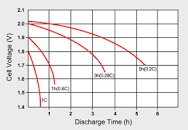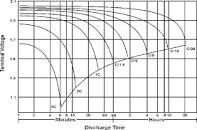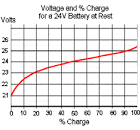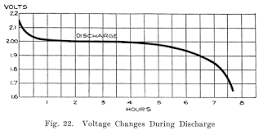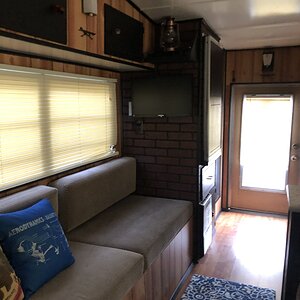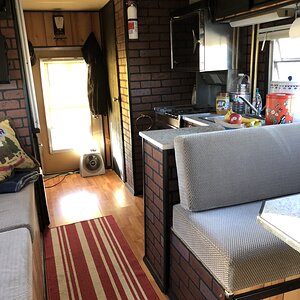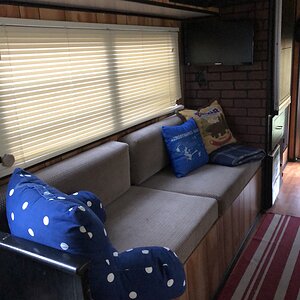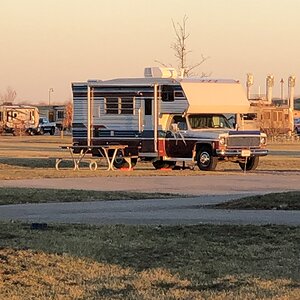Navigation
Install the app
How to install the app on iOS
Follow along with the video below to see how to install our site as a web app on your home screen.
Note: This feature may not be available in some browsers.
More options
Welcome to RVForums.com
- Register now and join the discussion
- Friendliest RV Community on the web
- Modern site for PC's, Phones, Tablets - no 3rd party apps required
- Ask questions, help others, review campgrounds
- Get the most out of the RV Lifestyle
- Invite everyone to RVForums.com and let's have fun
- Commercial/Vendors welcome
You are using an out of date browser. It may not display this or other websites correctly.
You should upgrade or use an alternative browser.
You should upgrade or use an alternative browser.
Question Dead Chassis Batteries in a Few Weeks?
- Thread starter CaptainGizmo
- Start date
Chuggs
RVF Supporter
- Joined
- Nov 3, 2019
- Messages
- 422
- RV Year
- 2016
- RV Make
- Newmar
- RV Model
- Ventana 4037
- RV Length
- 40’
- TOW/TOAD
- Jeep JKU
Well...if you guys are right —- a lot has changed since 2016...or perhaps the DSDP is that much different from the VTDP. That could be. Just wonder why the Newmar Engineers would depart from some form of standardized wiring process, for things that are common.
The handout below came in my Black Bag. I have highlighted things that are “Constant Battery Power”. IMPORTANT Note: These are on the HOUSE battery system...not the CHASSIS.
I have a Freightliner Chassis...and according to the EZ-Wiring from the DTNA website...(also attached below) you will see the only thing the Chassis Disconnect does it cut the two 2/0 power lines that terminate under the drivers seat in the basement compartment. So all of those circuits are de-powered. There are other things attached to the two Group 31 batteries not shown in the schematic I attached...so there are things that continue to be connected even with that disconnect switch thrown. There also should be a small red wire with an inline 7.5A fuse...labeled solar. I decided to check mine. It had blown. So for who knows how many years...that 10w ZAMP solar panel hasn‘t done anything but create wind drag. While I had the fuse out...I checked the Voc and it was about 17v open circuit. And attached to the batteries...about 0.3 amps of current going into the batteries. I replaced the fuse...so hopefully it’s doing something now. I’ll check it again when I do my annual service work in February to see if it’s still intact. I’m interested in pulling that solar panel up...to see if I can fish some new wires thru the existing loom. If I can...I’ll remove it and install a 200w panel and SmartSolar MPPT 75/15 controller. Then I know the Chassis Batteries will maintain themselves. It will also make it easier in the future to split my systems for LiFePO4 House Batteries in the far off future.
It seems odd the technician would list three things...that in a lot of coaches are not connected to the chassis batteries at all.


The handout below came in my Black Bag. I have highlighted things that are “Constant Battery Power”. IMPORTANT Note: These are on the HOUSE battery system...not the CHASSIS.
I have a Freightliner Chassis...and according to the EZ-Wiring from the DTNA website...(also attached below) you will see the only thing the Chassis Disconnect does it cut the two 2/0 power lines that terminate under the drivers seat in the basement compartment. So all of those circuits are de-powered. There are other things attached to the two Group 31 batteries not shown in the schematic I attached...so there are things that continue to be connected even with that disconnect switch thrown. There also should be a small red wire with an inline 7.5A fuse...labeled solar. I decided to check mine. It had blown. So for who knows how many years...that 10w ZAMP solar panel hasn‘t done anything but create wind drag. While I had the fuse out...I checked the Voc and it was about 17v open circuit. And attached to the batteries...about 0.3 amps of current going into the batteries. I replaced the fuse...so hopefully it’s doing something now. I’ll check it again when I do my annual service work in February to see if it’s still intact. I’m interested in pulling that solar panel up...to see if I can fish some new wires thru the existing loom. If I can...I’ll remove it and install a 200w panel and SmartSolar MPPT 75/15 controller. Then I know the Chassis Batteries will maintain themselves. It will also make it easier in the future to split my systems for LiFePO4 House Batteries in the far off future.
It seems odd the technician would list three things...that in a lot of coaches are not connected to the chassis batteries at all.
Last edited:
Old-RV'er
RVF Expert
- Joined
- Feb 23, 2020
- Messages
- 500
- Location
- Blairsville, GA
- RV Year
- 2019
- RV Make
- Newmar
- RV Model
- Ventana 3407
- RV Length
- 34'10"
- TOW/TOAD
- 2013 Jeep Wrangler Sahara Unlimited
- Fulltimer
- No
flyboy013
RVF VIP
- Joined
- Jul 24, 2020
- Messages
- 385
- Location
- Naples, Florida
- RV Year
- 2018
- RV Make
- Newmar
- RV Model
- Mountain Aire 4531
- RV Length
- 45
- Chassis
- Spartan K3
- Engine
- Cummins ISX12 (500HP)
- TOW/TOAD
- 2023 Jeep GC Summit Reserve
- Fulltimer
- Yes
I still have a chassis parasitic draw such that the battery will be down to 12.4 in about 3 days. It hasn't been much of a problem since the coach is plugged in nearly 24x7. Reading these posts makes me want to investigate the problem once again. I'll be in warm weather next month and it will give me a good opportunity to tackle the issue again.
Other than using the terminal imaging camera to find a device that's putting off some heat, are there any other good uses for it? Also if the "hot" device in behind the instrument cluster or tucked away somewhere, I would expect the effectiveness of the camera to be someone limited. Figure I'll try the clamp meter along with testing the voltage drop across the fuses.
Other than using the terminal imaging camera to find a device that's putting off some heat, are there any other good uses for it? Also if the "hot" device in behind the instrument cluster or tucked away somewhere, I would expect the effectiveness of the camera to be someone limited. Figure I'll try the clamp meter along with testing the voltage drop across the fuses.
Joe Hogan
RVF Supporter
- Joined
- Nov 3, 2019
- Messages
- 3,264
- Location
- Florida
- RV Year
- 2024
- RV Make
- Newmar
- RV Model
- Dutch Star 4311
- RV Length
- 43
- Chassis
- Spartan
- Engine
- Cummins
- TOW/TOAD
- 2018 Ford Flex
- Fulltimer
- No
If you are using a flooded acid battery,
 www.progressivedyn.com
www.progressivedyn.com
a lead acid battery will self-discharge at a rate of approximately 4% a week. A battery with a 125-amp hour rating would self-discharge at a rate of approximately five amps per week.
Home 3 - Progressive Dynamics
The Mighty Mini Compact All-In-One System offers an AC/DC Power Distribution Panel and Inteli-Power Converter with Charge Wizard battery charging technology.
Search Results
https://www.google.com/search?sourc...hUKEwjjnvnY3YruAhXGrFkKHYoPBIkQ420oAHoECBUQBAa lead acid battery will self-discharge at a rate of approximately 4% a week. A battery with a 125-amp hour rating would self-discharge at a rate of approximately five amps per week.
Attachments
Chuggs
RVF Supporter
- Joined
- Nov 3, 2019
- Messages
- 422
- RV Year
- 2016
- RV Make
- Newmar
- RV Model
- Ventana 4037
- RV Length
- 40’
- TOW/TOAD
- Jeep JKU
Interesting....
The tech paper put out by Interstate Battery for out GC-2 have charge recommendations per cell. So, wired in series to make 12v you have six cells.
They also use a different temp reference for thier charge parameters than the MS2812 Inverter uses so, I adjusted them.
Magnum
Absorb Voltage 14.51v
Float Voltage 13.43v
Equalization 15.65v
Temp comp...default -5mv/°c/cell
The “Charge Wizard” doesn’t really come close. What they are calling equalization is what the Magnum does everyday when it goes into “Absorb”...
The tech paper put out by Interstate Battery for out GC-2 have charge recommendations per cell. So, wired in series to make 12v you have six cells.
They also use a different temp reference for thier charge parameters than the MS2812 Inverter uses so, I adjusted them.
Magnum
Absorb Voltage 14.51v
Float Voltage 13.43v
Equalization 15.65v
Temp comp...default -5mv/°c/cell
The “Charge Wizard” doesn’t really come close. What they are calling equalization is what the Magnum does everyday when it goes into “Absorb”...
Similar threads
Latest resources
-
-
Trueline Leveling System (Valid Air)Operation & Service Manuals for the Valid Air leveling system
- Jim
- Updated:
-
-
Notes on the Electrical Systems of the Roadtrek Zion Family of RVsNotes on the Electrical Systems of the Roadtrek Zion Family of RVs
- dilbertjth
- Updated:
-
